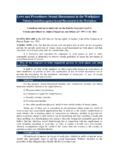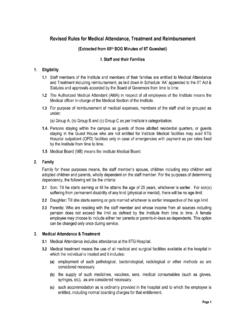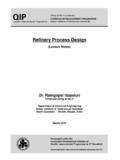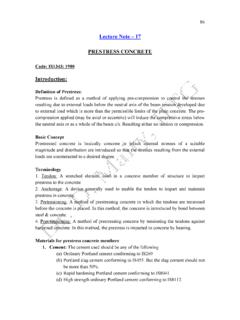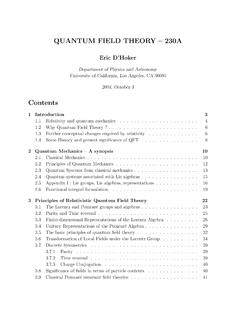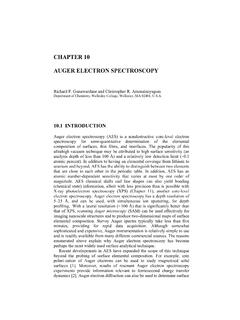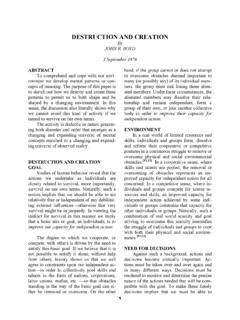Transcription of Lecture-XXIV Quantum Mechanics Expectation values and ...
1 Lecture-XXIVQ uantum MechanicsExpectation values and uncertaintyExpectation valuesWe are looking for Expectation values of position and momentum knowing the state of the particle, i,e., the wave function (x,t). Position Expectation :What exactly does this mean? It does not mean that if one measures the position of one particle over and over again, the average of the results will be given byOnthecontrary,thefirstmeasurement(whos eoutcomeisindeterminate)willOnthecontrar y,thefirstmeasurement(whoseoutcomeisinde terminate)willcollapse the wave function to a spike at the value actually obtained, and thesubsequent measurements (if they're performed quickly) will simply repeat that , <x> is the average of measurements performed on particles all in the state ,which means that either you must find some way of returning the particle to itsoriginal state after each measurement, or else you prepare awhole ensemble ofparticles, each in the same state , and measure the positions of all of them: <x> isthe average of these position Expectation may also be written as:**xxdxx dx + + == Momentum Expectation :Classically: Quantum mechanically, it is <p>Let us try:d<x>/dtis the velocity of theexpectation value ofx, not thevelocity of the that there is no dx/dt under the integral sign.
2 The only quantity that varies withtime is (x, t), and it is this variation that gives rise to a change in <x> with time. UsetheSchrodingerequationanditscomplexco njugatetoevaluatetheaboveandwetheSchrodi ngerequationanditscomplexconjugatetoeval uatetheaboveandwehaveNowThis means that the integrand has the form =Because the wave functions vanish at infinity, the first term does not contribute, andthe integral givesThis suggests that the momentum be represented by the differential operator pix As the position Expectation was represented by *xx dx + = To calculate Expectation values , operate the given operator on the wave function,have a product with the complex conjugate of the wave function and integrate.
3 Xx and the position operator be represented by What about other dynamical variables? ** andpp dxxx dx == Expectation of other dynamical variablesTo calculate the Expectation value of any dynamical quantity, first express in terms ofoperators x and p, then insert the resulting operator between * and , and integrate:For example: Kinetic energy2222m x = Therefore,2222( )( )22pHK VV xV xmm x =+=+= + Hamiltonian:Angular momentum :but does not occur for motion in one dimension. Could the momentum Expectation be imaginary?The Expectation value of pis always real. Let us calculateThe last step follows from the square integrability of the wave functions. Sometimesonehasoccasiontousefunctionstha tarenotsquareintegrablebutthatobeyonehas occasiontousefunctionsthatarenotsquarein tegrablebutthatobeyperiodic boundary conditions, such asAlso, under these circumstances An operator whose Expectation value for all admissible wave functions is real is called a Hermitian operator.
4 Therefore, the momentum operator is Hermitian. All Quantum mechanical operators corresponding to physical observables are then Hermitian of operators:Products of operators need careful definition, because theorder in which they act :They are different. However, one can deduce whereasSince this is true for all (x), we conclude that we have an operator relation, whichreadsThis is acommutation relation, and it is interesting because it is a relation betweenoperators, independent of what wave function this acts on. The difference betweenclassical physics and Quantum Mechanics lies in that physical variables are describedby operators and these do not necessarily commute.[],x pi= or( ),dff x pidx = In general one could show that:The Heisenberg uncertainty RelationsThe wave function (x) cannot describe a particle that is both well-localized in spaceand has a sharp momentum.
5 The uncertainty in the measurementis given 21 22222andxxxppp = = whereto be evaluated using position and momentum quantitative limitation on the accuracy with which we can describe a system usingour familiar, classical notions of position and momentum. Position and momentum aresaid to becomplementary(conjugate) 1:A particle of mass mis in the state where A and a are positive real constants. (a) FindA. (b) Calculate the expectationvalues of <x>, <x2>, <p>, and <p2>. (d) Find xand p. Is their product consistent withthe uncertainty principle?(a)(b)(b)Remember:(c)This is consistent with the uncertainty 2:Consider a particle whose normalized wave function is (a) For what value of x does P(x)=| |2peak? (b) Calculate <x> , <x2> and <p> , <p2>.
6 (c) Verify uncertainty relation. (a) The peak in P(x) occurs when dP(x)/dx= 0 that is, when ( )()( )( ) ()( )10 Gamma functions:for0,1;11 ! for is poistive and2nxnx e dxnnn nnnn => += = = = (b)2x2()()()()()()()30222323222220003223 222222220040 (Has to be real)44224422xxxxxxyxpixexedxxpxexedxxed xx edxxye dyx edx = = = = + = += += 222222222223333;,242;;33222xxxxppppx p = = = = = = = ==> (c)
